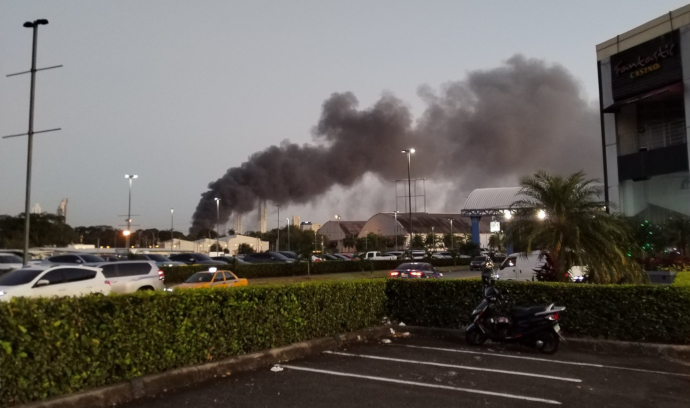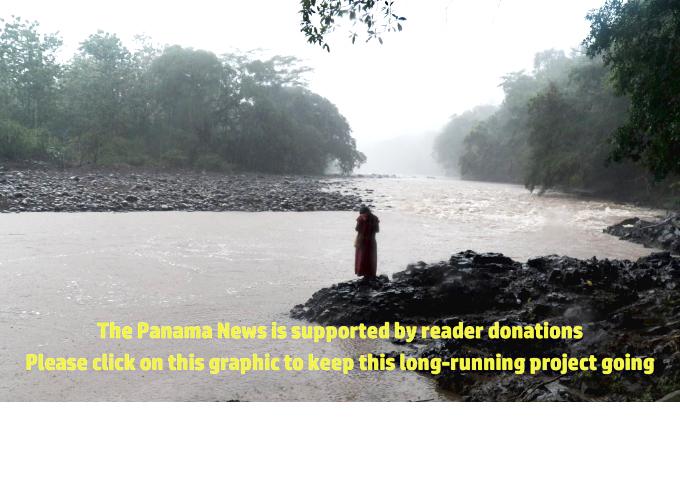Smoke rises from the Panama City corregimiento of Calidonia, as seen just before sundown from the Albrook Mall parking lot. Anonymous photo from Twitter / X.
Soon it will be the fire inspectors’ turn
a note by Eric Jackson
It was only a short distance from the site of Panama City’s most infamous fire — the “El Polvorín” blaze and explosion of May 5, 1914 in which six firefighters died when a clandestine fireworks factory blew up. This time it was Alfombras Mundiales, a warehouse near the Don Bosco Church in which carpeting was stored, that burned. Believed to have been started by some soldering work that dripped onto a flammable carpet, the first alarm went out shortly before 4 p.m. on December 4, but the first bomberos found a jumble of obstacles that prevented their entry into the building. The blaze rapidly got worse.
As the fire grew out of control more stations were called — ultimately four bombero companies and the PanCanal firefighters, more than 80 people in all, fought the blaze.
Was it a petrochemical fire — carpeting made from coal or oil-based synthetic fibers? That would seem probable at a glance, but the fire inspectors will need to examine the site and report, once the burning is over. If it was a chemical fire of that nature, would adjustments in fire safety law be in order?
Panama’s public fire and building safety system is the stuff of jokes — underfunded, disrespected, usually preventing nothing but coming into play after a disaster, so as to assign blame. But this was a thick and toxic cloud blowing over and into densely populated city neighborhoods, all the more toxic if from fossil-based fabrics.
Compounding the analysis of and response to such problems, Panama studiously refuses to fund any meaningful environmental health research. We know, for example, that corregimientos with no garbage pickup get the frequent stench of burning plastic, known to be carcinogenic, but there are no studies of, say, childhood leukemia cases in such areas to pressure local officials into dedicating resources to alleviate the problem via more costly solid waste collection and disposal systems. Financial pressures on soft drink companies that put enormous amounts of plastic into our neighborhoods and ecosystems are avoided. And heaven forbid any systematic data collection on public health in places where herbicides or pesticides are sprayed.
Of more immediate and common concern — illness and death from just a bit of toxic smoke inhalation being hard to trace over the long term — the bomberos found insufficient water pressure in the hydrants when it was needed to fight the blaze. We might well plead the drought’s effects, and those would be a factor, but for the same kinds of water pressure problems existing in non-drought times. A more efficient and professional IDAAN water and sewer authority? But that would empty out political pork barrels for hiring private contractors to maintain IDAAN infrastructures. And who’s this wise guy from The Panama News to suggest that the structure of the way it works creates opportunities for graft?
It all makes for some briefly compelling video clips that by the next news cycle blows over into an easily ignored but serious set of public health and governance problems.
Contact us by email at fund4thepanamanews@gmail.com
To fend off hackers, organized trolls and other online vandalism, our website comments feature is switched off. Instead, come to our Facebook page to join in the discussion.
These links are interactive — click on the boxes












